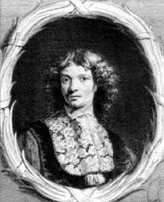Embryology History - 17th and 18th Century Anatomies
Introduction
We have been studying human development for a very long time. This page contains images and links to historic texts which have illustrated organizations and structures generally found in fetal development.
Page Links: [#Intro Introduction] | [#Spiegel Spiegel and Casseri (1626)] | [#Graaf Regnier de Graaf (1641 - 1673)] | [#Portal Paul Portal (1705)] | [#Bidloo Govard Bidloo (1690)] | [#Braune Braune] | [#Smellie William Smellie (1754)] | [#Hunter William Hunter (1774)] | [#IMSS Institute and Museum of the History of Science] | [#WWWLinks WWW Links] | [#Glossary Glossary]
Spiegel and Casseri
Spiegel and Casseri: De formato foetu liber singularis (1626)
Adriaan van den Spiegel (1578-1625)
Published posthumously by Spigelius' son-in-law, the physician Liberalis L. Crema of Padua.
NLM: http://www.nlm.nih.gov/exhibition/historicalanatomies/spiegel_home.html
Regnier de Graaf
Regnier de Graaf (1641 - 1673), a Dutch physician and anatomist. Doctoral thesis on the pancreas, identified the function of the ovarian follicle (named Graafian follicle), the final mature antral follicle released by ovulation.
De Graaf R. De virorum organis generationi inservientibus, de clysteribus et de usu siphonis in anatomia. Ex officina Hackiana, Lugd. Batav. et Roterod. 1668.
De Graaf R. De mulierum organis generationi inservientibus tractatus novus. Ex officina Hackiana, Lugd. Batav. 1672.
R. De Graaf. Alle de wercken, Abraham Abrahamse, Amsterdam (1686).
References:
Houtzager HL. Reinier De Graaf and his contribution to reproductive biology. Eur J Obstet Gynecol Reprod Biol. 2000 Jun;90(2):125-7. No abstract available.
Jay V. A portrait in history. The legacy of Reinier de Graaf. Arch Pathol Lab Med. 2000 Aug;124(8):1115-6. No abstract available.
Setchell BP. The contributions of Regnier de Graaf to reproductive biology. Eur J Obstet Gynecol Reprod Biol. 1974;4(1):1-13. No abstract available.
Wiesemann C. [Regnier de Graaf (1641-1673)] Pathologe. 1991 Nov;12(6):352-3. German. No abstract available.
Mann RJ. Regnier de Graaf, 1641-1673, investigator. Fertil Steril. 1976 Apr;27(4):466-8. No abstract available.
Modlin IM. Regnier de Graaf: Paris, purging, and the pancreas. J Clin Gastroenterol. 2000 Mar;30(2):109-13. No abstract available.
Paul Portal
Paul Portal: The Compleat Practice of Men and Women Midwives (1705)
"Paul Portal (1630-1703), French obstetrician, originally published this important treatise in Paris in 1696. It includes his demonstration of turning a fetus during childbirth using one foot and contains his teaching that face presentation runs a normal course during the labor process."
Historical Medical Digital Library: http://www.collphyphil.org/HMDLSubweb/Pages/P/PortalP/compramenPgAccess.htm
Govard Bidloo
Bidloo, Govard (1649 - 1713) Ontleding des menschelyken lichaams, Amsterdam: By de weduwe van Joannes van Someren, de erfgenaamen van Joannes van Dyk, Hendrik en de weduwe van Dirk Boom, 1690.
NLM: http://www.nlm.nih.gov/exhibition/historicalanatomies/bidloo_home.html
Braune
Braune, Wilhelm (1831-1892): Topographisch-anatomischer Atlas : nach Durchschnitten an gefrornen Cadavern, Leipzig: Verlag von Veit & Comp., 1867-1872. (Topographic-anatomical Atlas)
NLM: http://www.nlm.nih.gov/exhibition/historicalanatomies/braune_home.html
William Smellie
William Smellie: A sett of anatomical tables, with explanations, and an abridgment, of the practice of midwifery (1754)
He also helped develop the delivery forceps which by the late eighteenth century were a well-known standard obstetrical instrument. File:Smellie twins.jpg
NLM: http://www.nlm.nih.gov/exhibition/historicalanatomies/smellie_home.html
William Hunter
William Hunter (1718-1783) Anatomia uteri humani gravidi tabulis illustrata = The anatomy of the human gravid uterus exhibited in figures (1774)
NLM: http://www.nlm.nih.gov/exhibition/historicalanatomies/hunterw_home.html
Institute and Museum of the History of Science
"Specimens of obstetric models: the wax models are life-sized; the terracotta versions are reduced to a 1:3 scale. Together with the anatomical waxes in the Specola Museum in Florence, these models are among the most significant examples of the use of artistic techniques for teaching medicine and obstetrics to midwives and surgery students in Florentine hospitals at the end of the eighteenth century."
Links: Institute and Museum of the History of Science (Italy) Room XVIII. Surgery and obstetrics | IMSS - where we are | La Specola Museum (Italy)
WWW Links
National Library of medicine (USA) Historical Anatomies on the Web "Historical Anatomies on the Web is a digital project designed to give Internet users access to high quality images from important anatomical atlases in the Library's collection."
Institute and Museum of the History of Science (Italy) Room XVIII. Surgery and obstetrics
National Library of medicine (USA) History of Medicine
National Museum of Health and Medicine (USA) History of Medicine
National Museum of Health and Medicine (USA) Human Developmental Anatomy Center (HDAC) "Maintains the largest collection of embryologic material in the United States. The Center is a primary source for centralized research in developmental anatomy."
Smithsonian Institution Whatever Happened to Polio? " This exhibition marks the fiftieth anniversary of the announcement that Dr. Jonas Salk had developed a vaccine to prevent polio, the most notorious disease of the 20th century until AIDS appeared."
College of Physicians of Philadelphia Historical Medical Digital Library Copyright for the books in the Historical Medical Digital Library of the College of Physicians of Philadelphia is in the public domain.
This page is an introduction to historical references (Anatomies) in Embryology. Many of images are available as digital versions from the links to National Library of Medicine.
The links include links to an old text, A History of Science by Henry Smith Williams and Origin of the Species by Charles Darwin.

